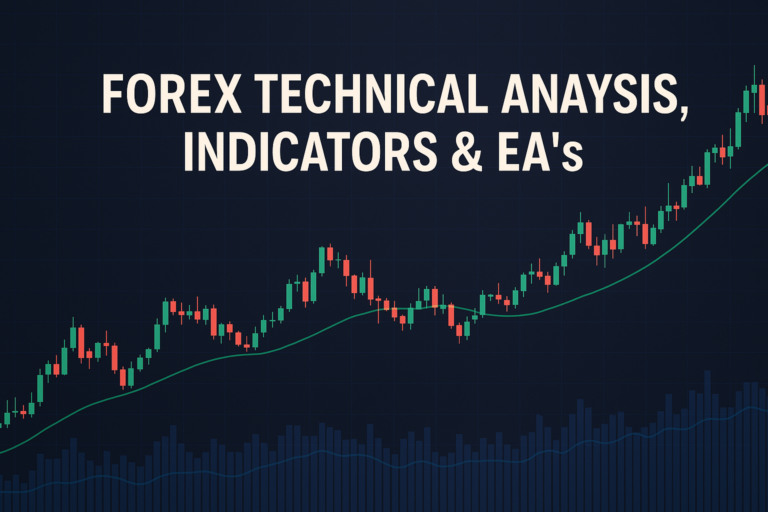
The Average Directional Movement Index (ADX) helps traders measure trend strength, guiding them in Forex trading strategies.
The Average Directional Movement Index (ADX) is a powerful tool in Forex trading that helps traders identify the strength of a trend. Picture it as a compass; it doesn’t show you where to go, but it tells you how strong the wind is blowing in a particular direction. Many traders, both beginners and professionals, struggle to grasp the concept of ADX. They find themselves lost in the numbers and lines, unsure of how to apply it effectively in their trading strategies.
Understanding and applying the Average Directional Movement Index (ADX) can be a game changer. This article will break down what ADX is, how it works, its history, advantages, and disadvantages, and provide you with practical strategies to implement it in your trading. So, buckle up as we embark on this exciting journey through the world of ADX in Forex trading!
What is the Average Directional Movement Index (ADX)?
The Average Directional Movement Index (ADX) is a technical analysis indicator that measures the strength of a trend. Imagine you are sailing on a boat. The ADX tells you how strong the wind is blowing, helping you decide whether to sail fast or slow. If the ADX is above 25, it indicates a strong trend, while below 20 suggests a weak or sideways market.
Types of Average Directional Movement Index (ADX)
There are several types of ADX calculations, including Simple, Exponential, and Weighted. Each type reacts differently to price changes. For example, Simple ADX might be easier for beginners, while Exponential ADX can provide faster signals for experienced traders. Choosing the right type depends on your trading style.
How Average Directional Movement Index (ADX) Smooths Out Price Action
The ADX smooths out price action by averaging directional movement over a set period, usually 14 days. This averaging process helps eliminate market noise, allowing traders to see the underlying trend more clearly. Think of it as filtering out the static so you can hear the clear message of the market.
Common Periods Used and Why
Most traders use a 14-period ADX because it balances responsiveness and reliability. However, you can experiment with different periods like 7 or 21 to see what works best for your strategy. Shorter periods react quickly, but they can be more volatile. Longer periods provide more stability, but they may lag behind the market.
The History of Average Directional Movement Index (ADX): How It Became Popular
Origin of Average Directional Movement Index (ADX)
The Average Directional Movement Index (ADX) was created by J. Welles Wilder in 1978. He wanted to develop a tool that could help traders identify trends in the market. Wilder’s innovative approach revolutionized technical analysis and became a staple for many traders.
When Did Traders Start Using It Widely?
Traders began to adopt the ADX in the 1980s after Wilder published his book, “New Concepts in Technical Trading Systems.” Its user-friendly design and practical applications made it popular among both new and experienced traders. The ADX continues to be widely used today.
Real-life Stories
Many professional traders have credited the ADX with helping them make significant profits. For example, one trader used the ADX to identify strong trends during the Forex market’s booming years, leading to substantial gains. Their success story inspired countless others to learn and apply the ADX in their trading journey.
Advantages and Disadvantages of Average Directional Movement Index (ADX)
Advantages:
The ADX offers several advantages for traders:
- Helps Identify Trends Easily: The ADX clearly shows whether a market is trending or not.
- Useful for Dynamic Support and Resistance: Traders can use it to adjust their support and resistance levels in trending markets.
- Works Well for Crossover Strategies: The ADX can be combined with other indicators to create effective buy/sell signals.
Disadvantages:
However, the ADX also has its drawbacks:
- lags Behind Price Movements: The ADX may take time to react, causing traders to miss early trend signals.
- Can Give False Signals in Sideways Markets: In choppy conditions, the ADX might suggest trends that aren’t really there.
How to Apply Average Directional Movement Index (ADX) on MT4 & MT5
Step-by-step Guide to Adding Average Directional Movement Index (ADX) on Charts
To add the ADX to your charts on MT4 or MT5, follow these simple steps:
- Open your trading platform.
- Select ‘Insert’ from the top menu.
- Choose ‘Indicators’ and find ‘Trend.’
- Select ‘Average Directional Movement Index.’
- Click ‘OK’ to display it on your chart.
Customizing Average Directional Movement Index (ADX) Settings
You can customize your ADX settings to fit your trading style. Adjust the period, color, and type of ADX to make it more visually appealing. For instance, you might choose a bright color to easily spot it against your chart’s background.
Saving Templates for Easy Application
Once you’ve set up the ADX to your liking, save it as a template. This way, you can apply the same settings to other charts effortlessly, saving you time when analyzing different currency pairs.
5 to 7 Trading Strategies Using Only Average Directional Movement Index (ADX)
All Time Frame Strategy (M5 to D1)
This strategy works on any time frame from M5 to D1. When the ADX rises above 25, it signals a strong trend. Buy when the ADX climbs above 25 and the price is above the moving average. Sell when the ADX crosses above 25 and the price is below the moving average. For example, if you see the ADX rising on a daily chart, consider entering a long position.
Trending Strategies
In a trending market, use the ADX to confirm the direction. If the ADX is above 25 and rising, it’s a buy signal. Conversely, if the ADX is above 25 and falling, it’s a sell signal. For instance, if the ADX shows strength while the price is rising, you can confidently enter a trade.
Counter Trade Strategies
When the ADX is below 20, it indicates a weak trend. You can use this information to take counter-trend trades. For example, if the price is falling but the ADX is low, consider a buy position. This strategy can yield good results in sideways markets.
Swing Trades Strategies
For swing trading, look for ADX crossovers. When the ADX rises above 20, watch for a potential reversal. For example, if the price has been falling and the ADX crosses above 20, it might indicate a swing upward is coming.
5 to 7 Trading Strategies Combining Average Directional Movement Index (ADX) with Other Indicators
Moving Average Convergence Divergence (MACD) Strategy
This strategy combines the ADX with the MACD indicator. When the ADX is above 25 and the MACD line crosses the signal line, it’s a strong buy signal. For example, if the ADX is rising and the MACD gives a bullish crossover, consider entering a trade.
Bollinger Bands Strategy
Use the ADX in conjunction with Bollinger Bands. When the ADX is above 25 and the price touches the upper band, it’s a sell signal. Conversely, if the price touches the lower band while the ADX is above 25, it’s a buy signal. This strategy helps confirm entries and exits.
Relative Strength Index (RSI) Strategy
When the ADX is above 20 and the RSI indicates overbought conditions, it may be a good time to sell. Similarly, if the ADX is above 20 and the RSI shows oversold conditions, it might be a good time to buy. This combination helps filter out false signals.
Fibonacci Retracement Strategy
Combine the ADX with Fibonacci retracement levels. If the price retraces to a key Fibonacci level while the ADX is above 25, it could confirm the trend. For example, if the price retraces to the 61.8% level and the ADX is strong, consider entering a trade in the direction of the trend.
Top 10 FAQs About Average Directional Movement Index (ADX)
1. What does an ADX value of 25 mean?
An ADX value of 25 indicates a strong trend. Traders often look for opportunities to enter trades in the direction of the trend.
2. Can I use ADX in a sideways market?
While the ADX can still provide signals in a sideways market, it is not as reliable. Low ADX values (below 20) suggest a lack of trend strength.
3. How do I interpret the ADX line?
The ADX line itself does not indicate the direction of the trend; it only measures its strength. Combine it with directional indicators (like +DI and -DI) for more insight.
4. Is high ADX always good?
A high ADX indicates a strong trend, but it doesn’t tell you if the trend is up or down. Always consider additional indicators to determine the trend’s direction.
5. How often should I check my ADX readings?
It depends on your trading style. Day traders may check ADX readings every few minutes, while swing traders may look at daily or weekly charts.
6. Can I use ADX alone for trading?
While the ADX is a powerful tool, it’s best used in conjunction with other indicators to confirm trade signals and reduce the risk of false signals.
7. What is the best period to set for ADX?
The most common period used for ADX is 14. However, you may experiment with different periods to find what works best for your trading style.
8. Does ADX repaint?
No, the ADX does not repaint. It is based on historical price data, so it provides a consistent reading after the period has closed.
9. Can I use ADX on all currency pairs?
Yes, you can use the ADX on any currency pair. However, it’s essential to consider the volatility and trading volume of the pair you choose.
10. How can I improve my ADX trading strategy?
Backtesting your strategies using historical data can help improve your ADX trading. Additionally, combining ADX with other indicators can enhance your trade signals.
Conclusion
Understanding the Average Directional Movement Index (ADX) is crucial for navigating the Forex market successfully. It provides valuable insights into trend strength, helping you make informed trading decisions. Remember to test different strategies and settings to find what works best for you. With practice and patience, you can harness the power of ADX to improve your trading outcomes.
Before risking real money, always practice your strategies in a demo account. This will help you gain confidence and refine your approach to using the Average Directional Movement Index (ADX) effectively.
Expand Your Knowledge
- 📌 Forex Trading Learning Road Map
- 📌 Forex Trading Course with no Fees
- 📌 Forex Trading Issues, Problems, and Solutions
- 📌 Forex Daily Forecast & Live Updates
- 📌 Forex Fundamental & News Analysis: Tomorrow’s Market Movers & Trade Opportunities
- 📌 Forex Education Hub: Learn & Profit
- 📌 Forex Technical Analysis, Indicators & EA’s
Start Trading Today
Ready to take your forex trading to the next level? Open an account with Exness, one of the most trusted platforms in the industry. 👉 Sign Up Now and start trading with confidence!
Exness stands out with ultra-low spreads for mini traders, instant withdrawals, and zero spread accounts for pro traders. Trusted since 2008, Exness offers lightning-fast execution, no hidden fees, and a secure, transparent trading environment—giving you the edge you need to succeed. 🚀 Join now and trade smarter!
Watch this helpful video to better understand Average Directional Movement Index (ADX):
Note: The video above is embedded from YouTube and is the property of its original creator. We do not own or take responsibility for the content or opinions expressed in the video.
In the video presented by Bill Paus from Profits Run, the focus is on the Average Directional Index (ADX), a technical indicator used in trading to gauge the strength of a market trend. The ADX does not indicate the direction of the trend—whether it’s upward or downward—but rather its intensity. Bill demonstrates the application of the ADX using the stock symbol for Ford Motor Company, with a 14-period setting for the indicator. He explains that when the ADX value is below 20, it suggests that the market is not trending effectively, meaning it may be experiencing sideways movement or “chop.” Conversely, as the ADX rises above 20, it indicates that a trend is developing, whether it is moving upwards or downwards.
Throughout the video, Bill illustrates how traders can use the ADX to identify opportunities and avoid choppy markets. He emphasizes that a rising ADX indicates a strengthening trend, while a declining ADX suggests the trend may be losing momentum. For example, he points out that when the ADX peaks and begins to fall but remains above 20, the market is still trending, albeit in a downward direction. Conversely, when the ADX drops below 20, it signals that the market is no longer trending, encouraging traders to look for better opportunities elsewhere. The key takeaway from the video is that the ADX serves as a valuable tool for traders, helping them filter out non-trending markets and focus on those with potential for profitable trades. Bill concludes by inviting viewers to subscribe to the Profits Run YouTube channel for more educational content on trading.




